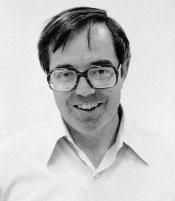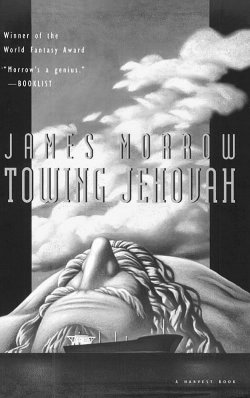 |
|
Talk of the Lab by Mike Perricone Father of the Idea
Father Thomas Wickliff Ockham, Jesuit priest and particle physicist, is the author of “The Mechanics of Grace” and “Superstrings and Salvation.” His favorite comfort clothes are jeans and a Fermilab sweatshirt.
“It’s just serendipity, as far as I can tell,” says James Morrow, author of the novel “Towing Jehovah,” in which Father Tom Ockham plays a major role. “He [Toohig] was obviously a remarkable man: more than remarkable—transcendent—so I’m delighted if I paid him some sort of oblique homage. If I had anybody consciously in mind for my Thomas Ockham character, it was probably the Benedictine priest Rev. Stanley Jaki of Seton Hall University (who is both a theologian and a physicist). Plus dashes of Thomas Merton and Teilhard de Chardin. But Tim Toohig actually sounds much closer to my vision of Father Ockham than any of those other three. I did tour Fermilab a year or so before I started writing ‘Towing Jehovah,’ during a World Science Fiction Convention in Chicago in the 1980s, so possibly I picked up whisperings and intimations of Father Tim Toohig.”
Morrow, winner of the World Fantasy Award, is at work on another novel with an even closer focus on physics.
“It’s called ‘The Last Witchfinder,’ he says, “and it’s about the meeting that almost took place in 1725 between Benjamin Franklin and Isaac Newton. In my novel, they really do meet. The narrator is Newton’s ‘Principia’—yes, this is a book written by a book—which enables me to talk about Heisenberg and Einstein and other post-Enlightenment scientists.”
And as for those scientists’ work attire...
“Do you really have Fermilab sweatshirts?” Morrow asks. “I was just making that up.”
Beyond Newton?
Benjamin Franklin was, indeed, tantalized by the prospect of meeting Sir Isaac Newton during his first sojourn in London from 1724 to 1726.
Franklin, barely into his 20s, wrote and printed an essay called “A Dissertation on Liberty and Necessity, Pleasure and Pain.” As biographer H.W. Brands relates in “The First American: The Life and Times of Benjamin Franklin,” the essay brought Franklin to the attention of London surgeon William Lyons and his intellectual circle, including “…Henry Pemberton, a friend of Isaac Newton. Pemberton delighted Franklin by promising to introduce him to the great scientist; he disappointed Franklin by failing to fulfill his promise.”
“ ‘Universal space, as far as we know of it, seems to be filled with a subtle fluid, whose motion, or vibration, is called light,’ Franklin wrote in a letter to the American Philosophical Society. The vibrations of light—sunlight, for example—heated objects on which the light fell by causing the particles of those objects to vibrate in turn. Franklin used the word ‘fire’ to denote a combination of electromagnetic, kinetic and chemical energy—a combination about which he was rather vague (and, in fact, confused). He was not sure whether this ‘fire’ was something material or immaterial (although in this he unknowingly anticipated the Einsteinian equivalence of mass and energy). But he hit on a fundamental law of conservation of mass-energy: ‘Thus, if fire be an original element, or kind of matter, its quantity is fixed and permanent in the world. We cannot destroy any part of it, or make addition to it; we can only separate it from that which confines it…’ ”
He was called “Dr. Franklin” in his time, and he might have been called the same by Newton.
|
 Father Tom Ockham could be mistaken for the late Father Tim Toohig (1928-2001), a Jesuit priest, particle physicist, and cornerstone of Fermilab from its founding days (FERMINEWS, vol. 24, no. 17, October 19, 2001). But the resemblance, as the standard disclaimer puts it, is unintentional and coincidental.
Father Tom Ockham could be mistaken for the late Father Tim Toohig (1928-2001), a Jesuit priest, particle physicist, and cornerstone of Fermilab from its founding days (FERMINEWS, vol. 24, no. 17, October 19, 2001). But the resemblance, as the standard disclaimer puts it, is unintentional and coincidental.
 Ockham, named for the 14th-century English philosopher William of Ockham, of “Ockham’s razor” fame, represents the Vatican in the most awesome salvage job in history. In “Towing Jehovah,” God has died, and his two-mile-long corpse has descended to rest in the Atlantic Ocean. Ockham directs the funeral procession: using an oil supertanker to tow the corpse to a sepulcher carved into an iceberg in the Arctic.
Ockham, named for the 14th-century English philosopher William of Ockham, of “Ockham’s razor” fame, represents the Vatican in the most awesome salvage job in history. In “Towing Jehovah,” God has died, and his two-mile-long corpse has descended to rest in the Atlantic Ocean. Ockham directs the funeral procession: using an oil supertanker to tow the corpse to a sepulcher carved into an iceberg in the Arctic.
 In his later years, Franklin thought and wrote of the physical sciences in ways that resonate in the 21st century. Brands examines Franklin’s theories:
In his later years, Franklin thought and wrote of the physical sciences in ways that resonate in the 21st century. Brands examines Franklin’s theories: